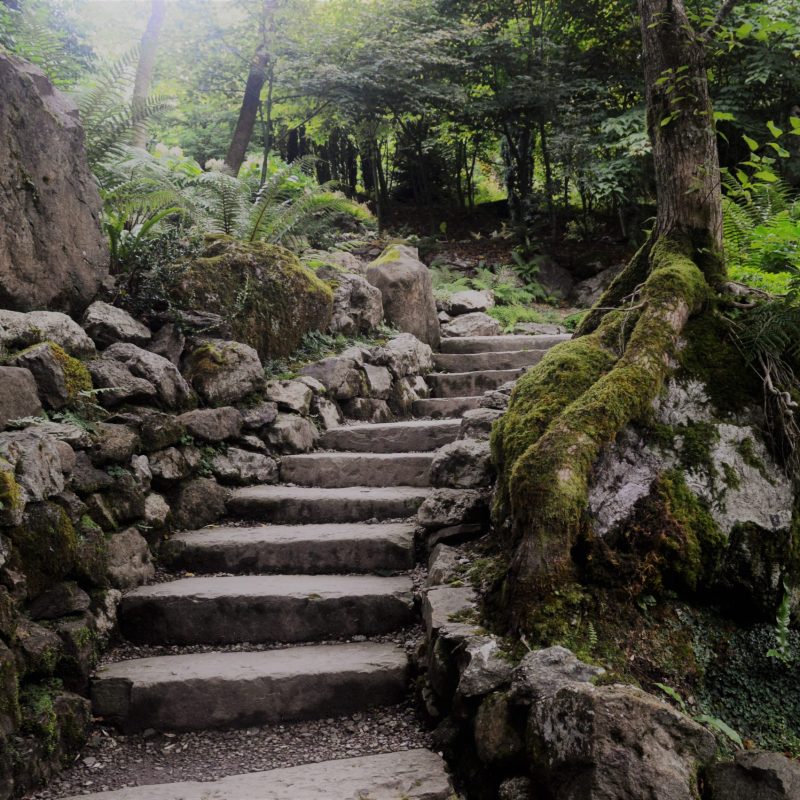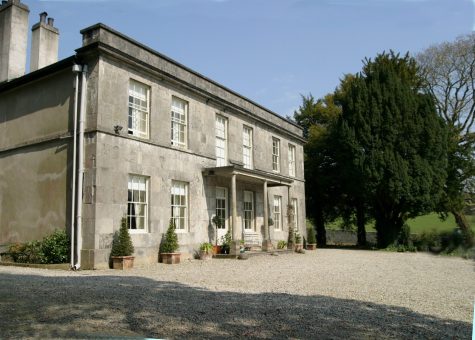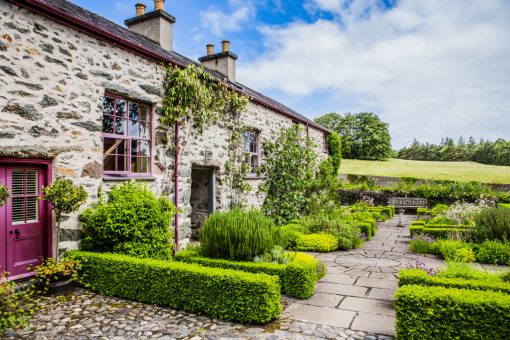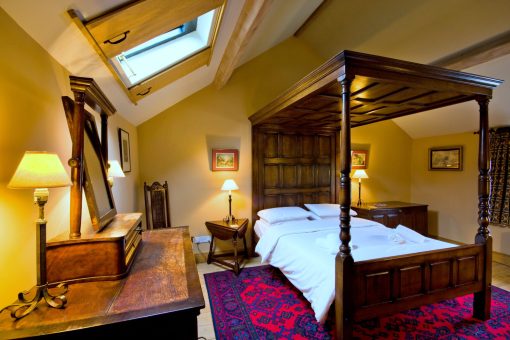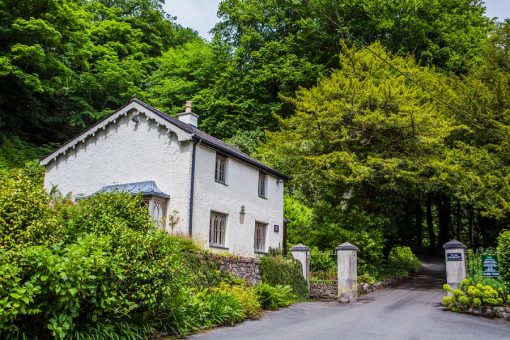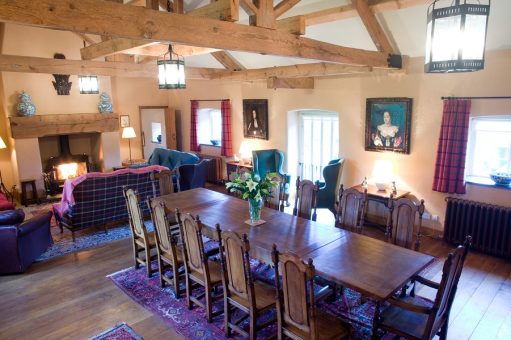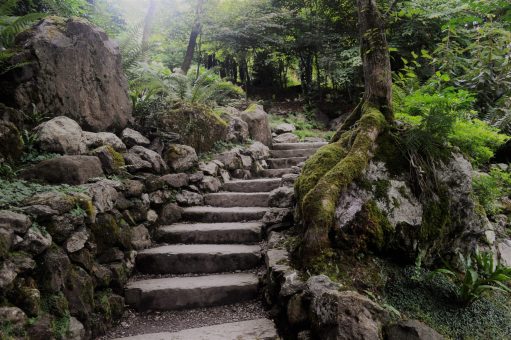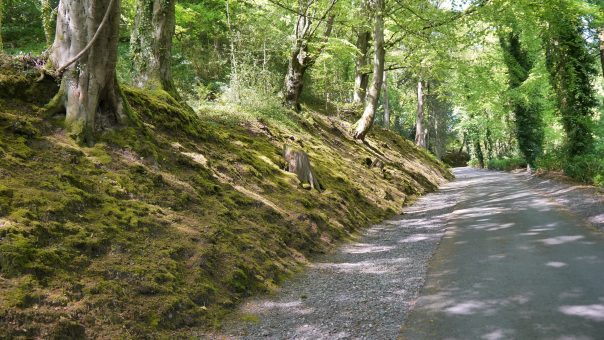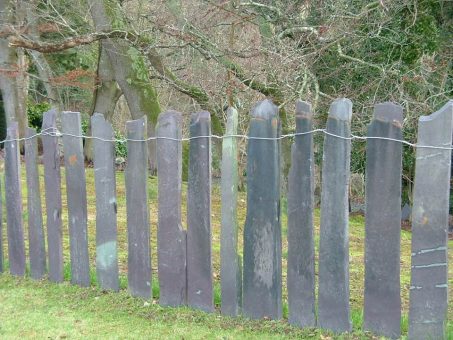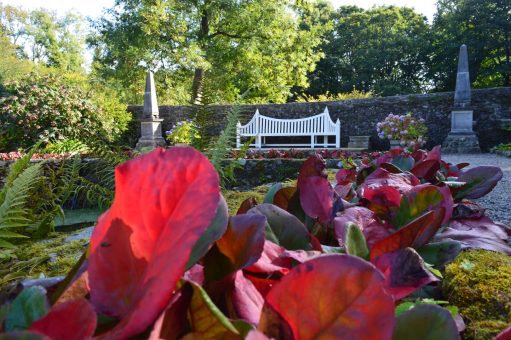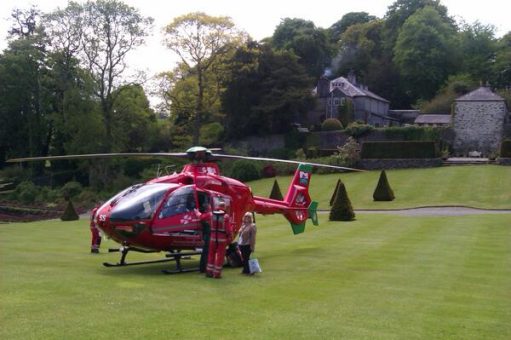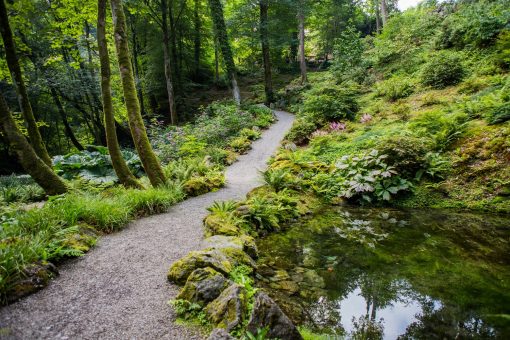Plas Cadnant story
Described as 'North Wales' best kept secret', Plas Cadnant is a unique 200-acre estate situated in a picturesque hidden valley on the Isle of Anglesey, overlooking the Menai Straits and the mountains of Snowdonia.
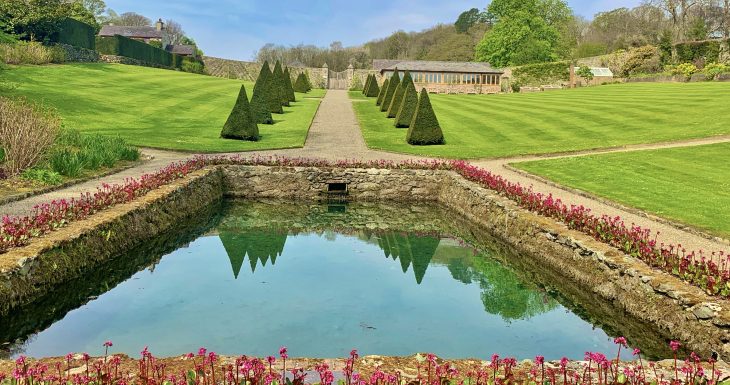
The Plas Cadnant Estate was created in 1803 by John Price Esq, landowner, and Agent to the Marquis of Anglesey.
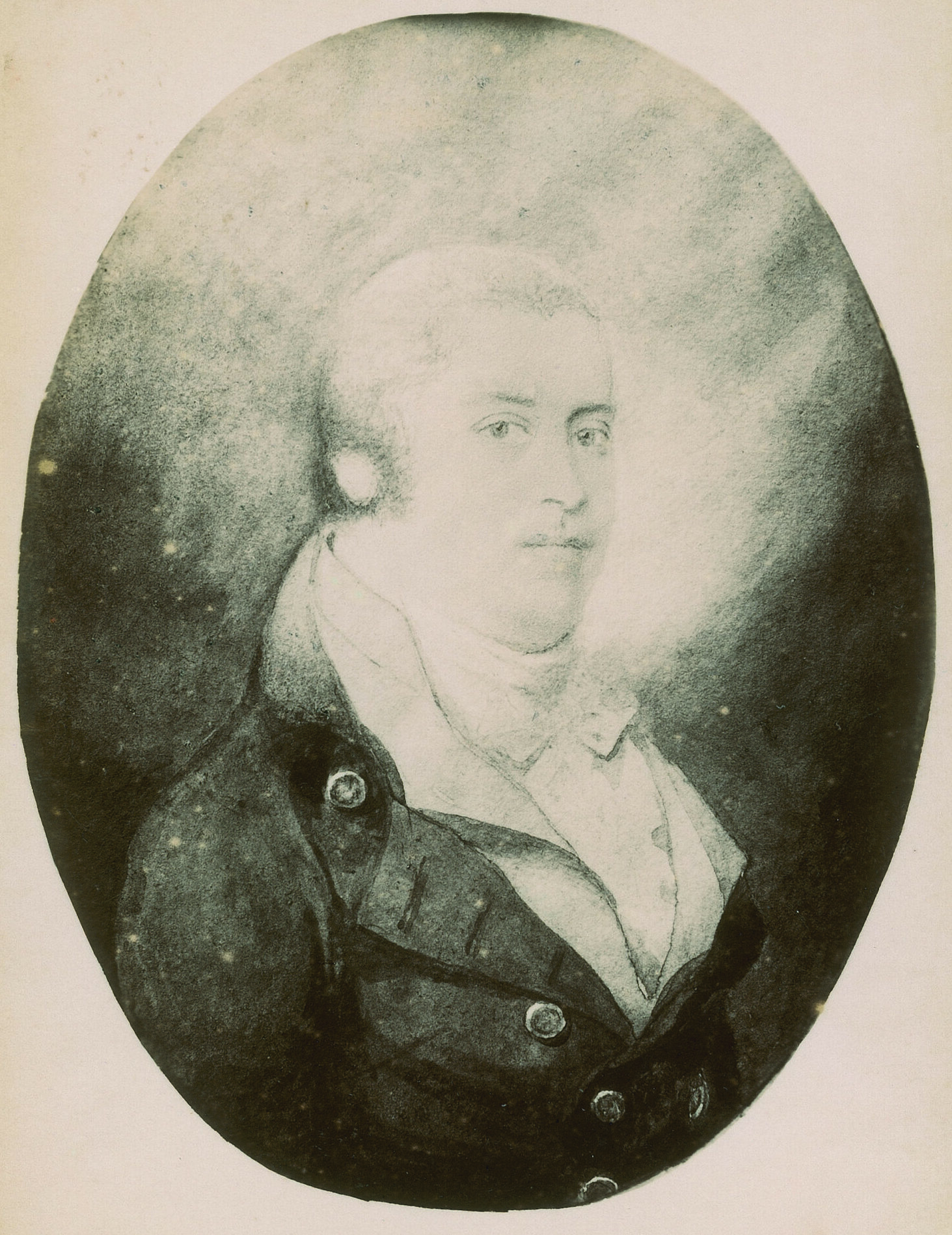
The house is a modest Georgian gentleman’s residence, believed to be of Irish design and is Grade II listed as a good example of a small early C19 country house retaining much of its original character both externally and internally. Some of its outbuildings are thought to pre-date the main house.
Extending to over 10 acres, the historic gardens have been restored over the last 30 years and are fast becoming a plantsman’s paradise. Now considered amongst the loveliest twenty gardens of Wales, the gardens are featured in a number of books including ‘The Finest Gardens of Wales’ by Tony Russell’ and ‘Discovering Welsh Gardens’ written by Stephen Anderton and photographed by Charles Hawes.
History of Plas Cadnant
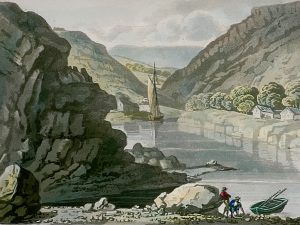
Early history of Cadnant
In 1096 an encampment was made at the mouth of the Afon Cadnant when forces led by the Earl of Chester crossed the Menai Strait onto Anglesey. By 1188, we see a medieval settlement named Cadnant at what had then become a regular crossing point.
Over the centuries there had been several attempts by the English to subjugate the Welsh nation and Anglesey did not escape these struggles. The many castles along the North Wales coastline, including nearby Beaumaris Castle, built by Edward I in 1295, bear evidence to this. However, by Edward’s reign the conflict between the two nations is already two hundred years old. In 1096 the Norman Earl of Chester, Hugh Lupus, landed his forces at the mouth of the Afon Cadnant, having made the treacherous crossing of the Menai Strait from the Welsh mainland. Some vestiges of the encampment constructed by his men are still evident today.
Difficult though the crossing from the mainland to the mouth of the Afon Cadnant may have been, it was one of the narrowest points of the Strait. With the first bridge still over seven hundred years away, it was inevitable that a ferry service of sorts, albeit rudimentary at first, would become established at this location. By 1188 a medieval settlement called Cadnant had grown up around the landing stage and residents would have seen Archbishop Baldwin of Canterbury, along with Gerald of Wales, disembark to speak to the people of Anglesey as part of their recruitment drive for the Third Crusade to the Holy Land. Gerald records that the archbishop addressed ‘the whole population of Anglesey from a rocky amphitheatre at Landisilio’. From the description it could have been where our main parking area is now located.
In 1292, Sir Roger de Puleston, the first Sherriff of Anglesey, refers in his accounts to the Cadnant ferry as ‘the Bishop of Bangor’s ferry’ or the Porthesgob ferry. It appears that the ferry not only crossed the Menai Strait to the mainland, but also plied the waters between Cadnant and Beaumaris. A survey of 1352 identifies a tenant of the Bishop of Bangor as being Ithel Borthwis, which translates from the Welsh as ‘Ithel the ferryman’.
The crossing was also used in 1646 during the English Civil War when Parliamentarians landed at Cadnant Creek on route to Beaumaris Castle to oust forces loyal to King Charles I. As the Cadnant settlement grew, woollen mills and a water mill for grinding flour were built alongside the fast-flowing waters of the Afon Cadnant, no doubt part of the agricultural revolution which turned the flat, fertile lands of Anglesey into ‘the bread basket of Wales’. There were several farms in the area including one on the site of Plas Cadnant called Tyddyn Rowlin, which is believed to have been built in the sixteenth century and still exists close to the main house today.
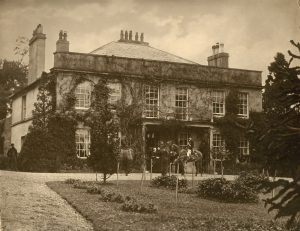
Development of the house and garden
It is in 1800 that the story relating to the house and gardens at Plas Cadnant really begins. In that year a local landowner called John Price was appointed Sherriff of Anglesey and agent to the Marquis of Anglesey and proceeded to build a house that would reflect his status.
John Price was born at Mona Lodge, Amlwch in October 1754 and in 1779 he had married Elinor Griffith, the daughter of a wealthy neighbouring farmer. As a result, he had both funds and some 3,000 acres (1214ha) of land at his disposal. This allowed him in 1803 to build a country gentleman’s residence which he then called Plas Cadnant. On John Price’s death in 1804, his 24-year-old son, also called John, continued his father’s work, whilst his mother raised his seven sibling brothers and sisters. In the years that followed John the younger set about developing a sizeable country estate which included clearing tenant farmers fields and creating parkland around the main house. By the time of the 1828 Census there are several buildings, houses and cottages belonging to the Plas Cadnant estate which are being used to house estate workers.
Although the exact date for the creation of a garden which befitted a prosperous country gentleman’s residence and estate is unclear, it is believed the two-acre south-east-facing and sloping walled garden, complete with its rectangular pool, may in fact pre-date Price and have been associated with the original Cadnant farmhouse of Tyddyn Rowlin. However, during the time of John Price the younger it would have been a productive and functional garden, providing vegetables, fruit and cut flowers for use within the main house. It included at least three glasshouses to enable the head gardener and his under gardeners to grow plants throughout the year and to establish tender crops, such as melons, peaches and vines, which needed added protection from the elements.
Food for the table is one thing, but it was also the fashion for gardens to be not only functional but aesthetically pleasing too. John Price, like his father before him, had been appointed Sheriff of Anglesey in 1818 and would have known the nearby estate of the Marquis of Anglesey at Plas Newydd very well. The Marquis had employed Humphry Repton to re-design the grounds of Plas Newydd in the Picturesque style of the day, which encompassed the appreciation of natural wilderness, harnessing and enhancing its beauty to create a garden landscape akin to Arcadia. It wasn’t long before Price was also creating his own version of paradise in the valley below the Plas Cadnant walled garden, which ran right down to the banks of the crystal clear and fast-running waters of Afon Cadnant.
On this steep bank he laid out a network of meandering pathways through the valley woodland and alongside these paths planted an intimate mixture of native and exotic trees, shrubs and other plants to provide colour and interest. Elsewhere he embellished natural rock outcrops making them focal points in the landscape and developed streams into waterfalls, all to accentuate the rugged beauty of the landscape.
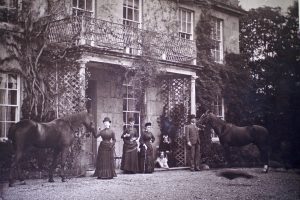
A chequered history follows
By 1826, Cadnant was no longer important as a ferry crossing point and deaths in the Lloyd family meant that it was rented out for long periods; the estate declined, and eventually passed out of the Price family when it was sold at auction in 1928.
In 1826 Thomas Telford’s much acclaimed new suspension bridge was built just a stone’s throw from the mouth of the Afon Cadnant, meaning that from then on visitors to Plas Cadnant no longer had to rely upon the ferry to cross the Menai Strait. However, in September 1838 this fast-flowing stretch of water claimed the life of John Price the younger’s youngest son William Bulkeley Price who fell out of a skiff whilst on a fishing excursion and drowned.
John Price the younger died in 1855. By then not only had he lost William Bulkeley Price in the drowning accident, he had also lost his eldest son Lloyd John Price in 1851. With no immediate heir, the estate passed to his eldest grandson John Bulkeley Price. As he was only five years old the estate was placed under the guardianship of trustees until he came of age in 1871. During these years Plas Cadnant was let out and some of its artefacts and furnishings sold off.
On his 21st birthday John Bulkeley Price returned to Plas Cadnant as the young squire. He was received with much celebration, but it appears that over the following years he spent little time here and the estate was again rented out whilst he served in the army. Eventually John Bulkeley Price, his widowed mother and his sisters returned to live at Plas Cadnant. After his death, his sister Catherine Louisa, who was effectively the last surviving member of the family, continued to live on the estate until 1928.
On Catherine’s death in 1928 the house and its remaining 900 acres (364 hectares) were split into lots and sold at auction.
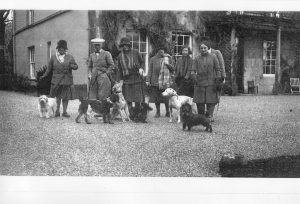
The Fanning-Evans family
Lot one at the 1928 auction: ‘The attractive family residence known as Plas Cadnant’ was bought, along with both the walled and woodland gardens, by Major Thomas Fanning-Evans and his wife Maud, but by 1993, the house and gardens were for sale again.
Upon taking up residence, the Fanning-Evans’ spent a considerable amount of money modernising the house and creating a new smart tennis court. However, when military service called the family overseas, Plas Cadnant was rented out again. Inevitably signs of neglect began to creep into the far reaches of the garden. After Major Thomas Fanning-Evans death in 1944 his son Claud and wife Elizabeth, who was a keen gardener and a cousin of the Tremayne family who owned Heligan in Cornwall, returned to live at Plas Cadnant. However, the family’s periodic post-war absences and the shortage of manpower made it difficult to maintain such an extensive garden. Elizabeth continued to garden a corner of the walled garden, planting it as an ornamental collection of shrubs and other exotics, some of which survive to this day, but the rest of the garden entered a stage of gentle decline which continued for more than three decades.
Claud Fanning-Evans died at Plas Cadnant in 1989 and in 1993 Elizabeth moved to a more manageable home nearby. Towards the end of Elizabeth’s time at Plas Cadnant, she was assisted by a single gardener one day a week. The property was sold to a farmer who had plans to turn the estate into an equestrian centre. Less than three years later in 1996 Plas Cadnant was once again up for sale.
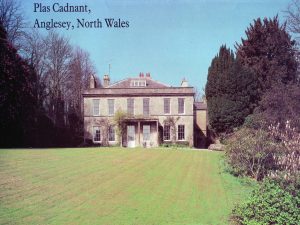
A new era
The next owner was to be someone who had the vision to see beyond the dilapidation and an understanding that it could be possible to restore the gardens of Plas Cadnant to their former glory - that man was Anthony Tavernor.
Anthony Tavernor first saw Plas Cadnant in 1996 whilst he was farming in Staffordshire. At that time, he had recently sold some property and was looking to purchase another farm. Plas Cadnant was advertised for sale in Country Life magazine and although he had no previous connections with Anglesey or even North Wales, there were several things about the property that appealed to him.
From an early age Anthony had been interested in gardens, history and architecture. At the tender age of 13 he carried out his first ‘landscaping job’ which involved building a waterfall with pools. Before leaving school he seriously considered studying horticulture at the Royal Botanical Gardens, Kew. However, as the son of a farmer, he felt it was his duty to follow in the family tradition. Even so, almost every spare moment away from the farm was spent visiting gardens.
The restoration journey
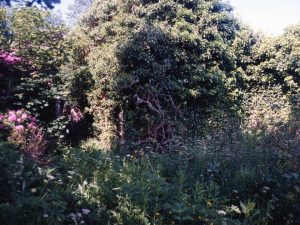
‘Love at First Sight’
What Anthony read in Country Life seemed to suggest that at Plas Cadnant he could potentially bring all his lifelong interests into one location. So, he arranged a viewing and in his own words, ‘It was a classic case of falling in love with a place on first sight’.
Back in 1996, Plas Cadnant certainly looked nothing like it does today. The main house (Plas), or ‘gentlemen’s country residence’, was just about liveable, but even so it still required a lot of work. Elsewhere, the original 16th century farmhouse and its associated outbuildings were either derelict or in varying degrees of disrepair and to make matters worse, there were at least 20 large ash trees leaning precariously over them which had the potential to come crashing down at any moment!
The walled garden was unrecognisable as such. It had become a wood and was completely overgrown with self-sown sycamore trees, Rhododendron ponticum, cherry laurel and head-high brambles. In one area the remains of three totally derelict glasshouses could only be reached by using a chainsaw to cut routes through to them. The wall itself had been breached in several places by a combination of falling trees, roots undermining foundations and indiscriminate holes punched through by previous owners.
There was however one corner of the walled garden which showed some signs of relatively recent cultivation and included several thriving specimen shrubs such as Buddleja alternifolia, Magnolia x soulangeana and Eucryphia x nymansensis ‘Nymansay’. This gave Anthony a clue to the fertility of the garden and its potential to support a collection of interesting, unusual and ornamental plants.
Beyond and below the walled garden there was absolutely no sign of cultivation whatsoever. However, he could tell from the topography that the ground fell away quite steeply into a densely wooded valley and the sound of moving water suggested a stream or river flowed through the valley bottom, but so thick was the vegetation it was impossible to reach.
Despite the serious amount of work required to bring the property back to its former glory, Anthony was smitten and by February 1996 he had bought Plas Cadnant, gaining possession in May of the same year.
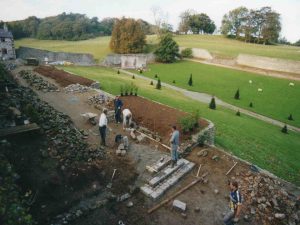
Restoration of the buildings and walled garden
It became clear to Anthony that he did not have a grand plan and in truth it was difficult to know where to start on the restoration of such an astonishing and diverse property. Anthony’s heart suggested the garden, his head the buildings and eventually they both won.
Whilst planning permission was sought to restore the entrance lodge and plans were being drawn up for the other buildings, Anthony began to carefully clear the two-acre walled garden, using old Ordnance Survey maps to indicate what might once have been there. These maps showed the line of the original footpaths and where possible they have been re-instated along the same lines. It was decided that only one of the three glasshouses could be restored, and this was the smallest. After extensive research it became clear that this had been an early ‘pit house’, used for growing pineapples and beneath the raised beds some of the original flues, which had originally heated the soil, were discovered. At one side of the building was a shallow stone-built evaporation tray, which in the Victorian era would have been filled with water to increase humidity and act as a form of pest control.
Research showed that the original use of the walled garden was to produce vegetables, fruit and cut flowers for the main house. However, to return it to such intensive productivity would have required a large labour-force with all its associated costs. So, Anthony decided to develop it as an ornamental garden but in a simple, not over-designed way. This was achieved by using a mixture of the Arts & Crafts movement’s attention to detail but with specific nods in the direction of former times – such as can be seen today in the recently planted fruit trees and the re-creation of a small kitchen/cutting garden.
By 2000 the original farmhouse and outbuildings had all been restored and Anthony decided to offer them as self-catering holiday accommodation. This turned out to be a wise decision as they quickly became popular with those who wished to holiday on Anglesey whilst staying in a beautiful garden location. Today they are an important source of income and contribute funding to the on-going garden restoration. It is important to understand that all work undertaken to date at Plas Cadnant has been largely financed by Anthony Tavernor; this really has been a labour of love for the one-time farmer from Staffordshire.
Once the buildings had been restored, Anthony was able to devote more time to the garden and here work has continued at an astonishing pace ever since. Within the walled garden the lawns have been laid, pyramid yew topiary planted and regularly clipped into the desired shape, rectangular pool restored, hedges planted, and double herbaceous borders designed and established against the eastern wall. Perhaps the most dramatic new development of all, has been the creation of the western terrace and its series of gardens, which has not only removed some of the previous steepness found on this side of the walled garden but enabled collections of plants to be displayed which bring colour and interest from spring right through until autumn.
Additional research of the south-eastern corner of the walled garden (which when Anthony first arrived had been the only part of Plas Cadnant to show indications of relatively recent cultivation) revealed that it had in fact been gardened until the late 1980s by previous owner Mrs Elizabeth Fanning-Evans. The work that Anthony has done in this area since his arrival has been sympathetic to and founded upon that already achieved by Mrs Fanning-Evans. Anthony was helped by the late botanist and plantsman, Philip Brown, to select what plants to introduce to the gardens.
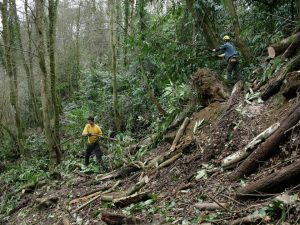
Restoration of the valley garden
In more recent times the focus of the restoration shifted to the ‘hidden valley’ below the walled garden. Impenetrable for decades, Anthony’s early research of this area revealed that this was not just a typical Anglesey wooded valley.
As well as being listed as an SSSI (Site of Special Scientific Interest) because of its abundance of rare and unusual ferns, mosses and lichens and its resident red squirrel population, the valley’s dense forest of cherry laurel was disguising the fact that this had at one time been a woodland garden designed in the Picturesque-style much promoted by the likes of Humphry Repton, who worked at nearby Plas Newydd in the early part of the 19th century. The Picturesque-style sought to embrace the natural beauty of landscapes whilst at the same time ‘aesthetically improving them for the human eye’ by the inclusion of ‘man-placed’ dramatic features. At Plas Cadnant these would have included meandering paths, sinuous flights of stone steps, dramatic reveals, viewing platforms, cascades, pools, waterfalls and rock formations.
Tentative expeditions into the valley with chainsaw in hand revealed to Anthony that some of these features still existed. Gradually over the past few years more and more of these original features have been re-discovered and where they were beyond restoration, or in some cases had completely disappeared, Anthony has not only re-instated them but expanded into adjacent areas with his own concept of the Picturesque.
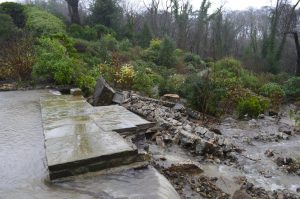
Devastation on Boxing Day
On Boxing Day 2015, following weeks of heavy rain and during the peak of Storm Eva, approximately four inches of rain fell onto the already saturated land above the gardens, washing into the Walled Garden and totally overwhelming the existing outlets. Extensive restoration would be needed.
The 200 plus year old walls acted as a dam causing the Walled Garden to fill like a tank until the lower wall eventually gave way leading to a ‘tsunami’ of water and rocks surging through the Valley Gardens into the river, scouring some areas down to the bedrock. Thankfully nobody was injured and none of the buildings were affected. Much of the damage was to structures including footpaths, walls, bridges and the parking area. A newly commissioned decorative wooden bench, and two stone obelisks were also washed downhill and deposited into the Cadnant river below.
The landscaped areas between the walled garden and waterfalls, were ruined. Fortunately, only a relatively small area of the planting was damaged, and we were able to salvage a good proportion of the plants from the affected areas.
A large part of the garden restoration was completed in time to open in April of 2016, with the Valley Gardens having been made safe and temporary paths laid. A structural engineer was brought on to design the new retaining wall as it is integral to the adjacent pool and needed to be able to cope with any future flooding and extra openings have been incorporated into the wall to release any excess water. Logistically, the rebuilding of the wall was challenging as the only access to the site was through a small doorway and along narrow pathways, impossible for large machinery. Being an historic garden, it was important to ensure that the work was carried out in a sensitive manner to respect the character and history of the site.
The rebuild costing over £250,000 and mostly covered by insurers NFU Mutual was completed in early 2017. A special celebration was held at the start of the season to celebrate the completion of the work and to thank the many people who supported the gardens during their recovery.
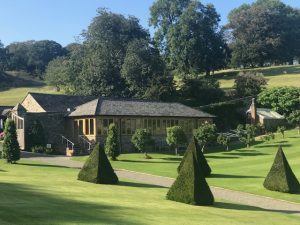
The future
The ultimate plan for Plas Cadnant is to put the gardens on a sustainable footing to allow future generations of visitors to enjoy the unique beauty of the Hidden Gardens and to ensure they are not again left lost and neglected.
This work at Plas Cadnant is far from complete, there is still much more that Anthony wishes to accomplish, even so, as you walk the grounds and gardens of Plas Cadnant you will undoubtedly be astonished at what one man, with minimal help, has managed to achieve in such a short space of time. Perhaps Anthony’s greatest success is that he has managed to carry out all this work without losing the feeling that this is still a private and very personal garden and as such is far removed from some of the more institutionalised garden restoration projects elsewhere that have taken place over the past quarter century.
A Royal visit
In July of 2017, the gardens were honoured to be visited by a King Charles, then Prince of Wales.
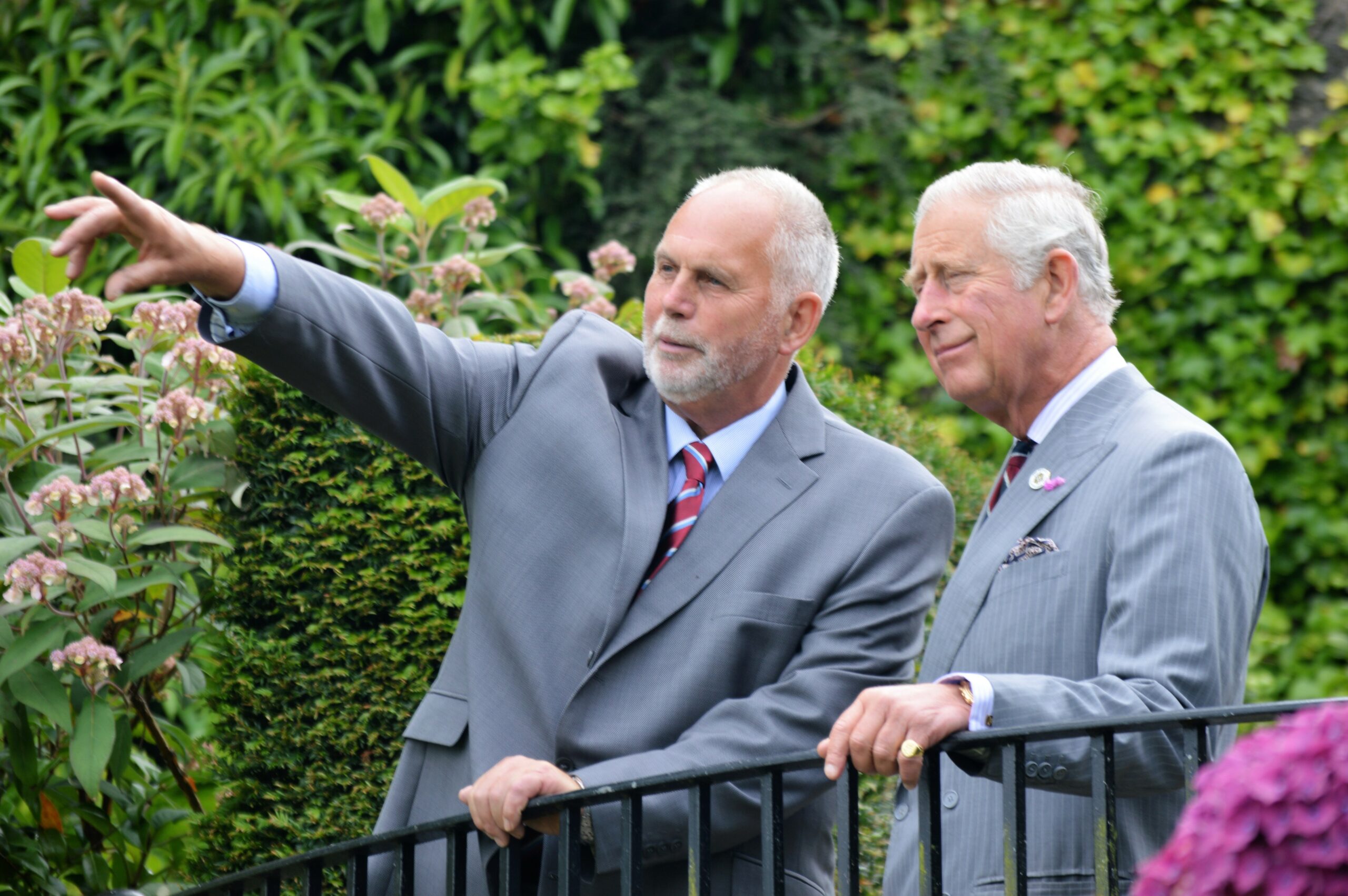
The king, famed for his love of nature, flora and fauna, was taken on a private tour of the garden where he met key members of staff and contributors.
He also planted an Acer ‘Seiryu’ to replace one that was lost in the flood before he joined the guests for afternoon tea at the main house (Plas).
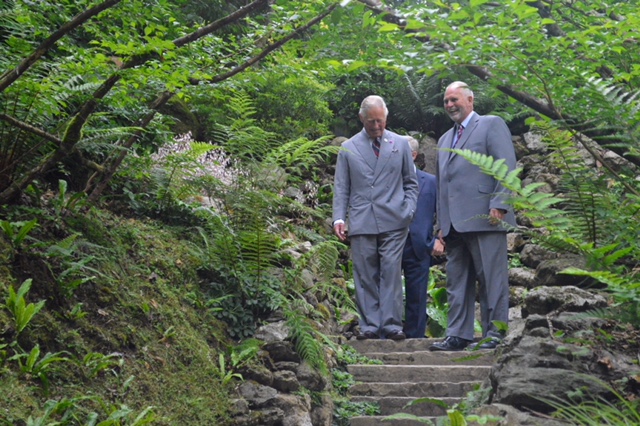
Plas Cadnant today
Plas Cadnant is not what you might expect of a private country estate.
It’s a peaceful place to relax with a warm and friendly atmosphere, where you can wind down and get in touch with nature once again.
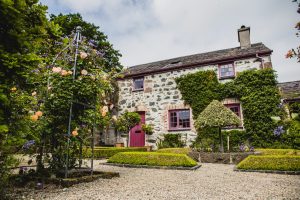
Cottages
The estate included five unique self-catering cottages, set within 10 acres of beautiful gardens that are surrounded by 200 acres of rolling parkland.
The cottages provide a perfect location to get away from the hustle and bustle of everyday life, and only a short drive from local amenities and tourist attractions. Four of the cottages are situated behind the main house and adjacent to the Walled Garden; the original buildings are thought to pre-date the main house and were utilised as outbuildings during the tenure of the Price family. The final cottage is a lodge by the main entrance, once the residence of past head gardeners.
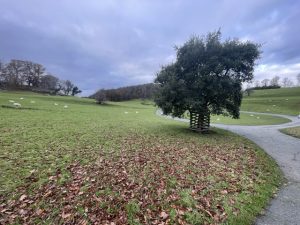
Parkland
We have utilised part of the park land for visitor parking during our public open days.
This area has been upgraded with a ground protection and reinforcement system which comprises a system of recycled plastic, interlocking mats that support the pedestrian and vehicular traffic while maintaining the parkland aesthetics.
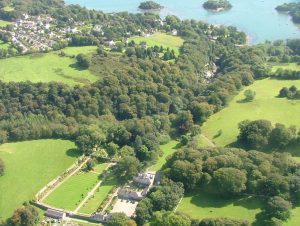
Cwm Cadnant, Site of Special Scientific Interest
The Dingle, the heavily wooded valley, is a very special habitat and home to many rare native species of plants and wildlife.
It is protected, therefore, as a Site of Special Scientific Interest (SSSI) one of the few woodland SSSI sites nationwide. Plas Cadnant and Natural Resources Wales work in partnership by removing invasive non-native shrubs like laurel to best conserve the ancient semi-natural woodland, which includes oak and ash trees around the Afon Cadnant and its waterfalls.
“The Bluebell Glade” is part of the SSSI and home to the carpets of native Welsh bluebell and wood anemones in spring. They are indicators of the ancient woodlands which harbour a rich fern and moss flora. The rich ecosystem and SSSI designation depend on the long history of the woodland cover and the humid conditions of the gorge which have made this environment so special. Experiencing the Bluebell Glade in spring is a feast for the senses.
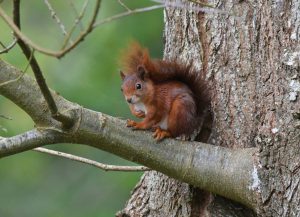
Plas Cadnant’s Red Squirrels
Plas Cadnant works in partnership with the Red Squirrels Trust Wales, which provides nesting boxes in quiet areas of the garden to enable red squirrels to raise their young in peace.
A British native species, red squirrels are severely threatened by the larger disease-carrying grey squirrels. Today red squirrels survive in more remote areas of Britain such as Anglesey, Northumberland and Scotland, thanks to careful management of both species.
The Anglesey Red Squirrel project illustrates how strong community partnership, conservation and education can transform red squirrels’ future. The Anglesey population, around 40 in 1997, is 400-500 strong today – the largest red squirrel population in Wales. Our SSSI woodlands contribute by providing them with a perfect breeding environment.
Here at Plas Cadnant we plant red squirrel food-friendly plants, supplemented with feeding stations throughout the woods providing: sunflower seeds, chopped apple, carrot and calcium, in the form of cuttlefish, to supplement their wild foods.
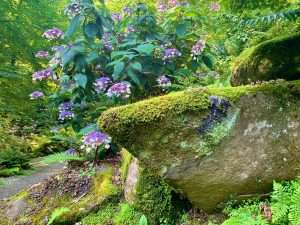
Plas Cadnant’s Geological Landscape
Plas Cadnant’s landscape spans 550 million years and is part of Anglesey’s UNESCO recognised Geo- Park coastline.
During the last Ice Age (25,000 to 12,000 years ago) kilometre-thick ice sheets and melt-water channels gouged the three valleys at Plas Cadnant out of the rock. As the ice melted, sea-levels rose forming the Menai Strait.
Geological evidence of lava having been forced into the earth’s crust, then cooling to form what are known as dykes around 65 million years ago can be seen near the ravine as dolerite, a dark crystalline rock. Plas Cadant’s dyke features in the first systematic geological survey of Anglesey in 1822 by the pioneering geologist, John Stevens Henslow. Dolerite weathers to become the red or copper-brown semi-precious stone Jasper visible in the River Cadnant, popular for jewellery in Queen Victoria’s reign.
Below the garden lies 550-million-year-old mainly Pre-Cambrian green schist formed by volcanic activity. The island’s varied geology explains the Estate’s varied soils which encourage such a range of plants to flourish.
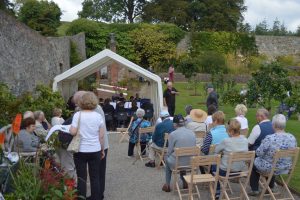
Fundraising / Helping the Local Community
Plas Cadnant has a strong relationship with the Menai Bridge & District Civic Society.
The Society’s aim is to ensure that we preserve green spaces, protect our designated Conservation area and encourage high standards of planning, design and civic life.
The Civic Society have held their annual fundraising garden party at Plas Cadnant since 2016. We have also hosted fundraising events for the cancer unit at the local hospital and frequently support nearby charities with their fundraising efforts. Each year we also hold an NGS open day where all admission fees are donated to charities.
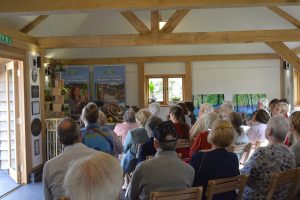
Education & Training Courses
In conjunction with the WFGA, we now offer training days, including pruning and staking.
We run a weekly schedule of guided walks and events to give visitors the chance to learn about various aspects of Plas Cadnant, including red squirrel walks, gardener’s walks, wildlife walks, meet the beekeeper days, geology walks, artist walks, and spinning and weaving showcases.
Plas Cadnant Hidden Gardens are free to access for members of Historic Houses.
Success and Accolades
Millennium Marque Award for Environmental Excellence 2000
Country Life Country Garden Award 2009 – Shortlisted
National Tourism Awards for Wales Best Place to Stay Self-Catering 2013 – Winner
Menai Bridge & District Civic Society Award for Excellence in Civic Design 2013
Council for the Protection of Rural Wales Award for the care of local environment
Visit Wales Hidden Gem 2016
Visit Wales Hidden Gem 2017
Visit Wales Quality Café 2017
Visit Wales Hidden Gem 2018
Visit Wales Quality Café 2018
HH Garden of the Year 2019 – Shortlisted
Trip Advisor Certificate of Excellence 2015 – 2019
Trip Advisor Travellers’ Choice Award 2020 – 2023
The English Garden’s “Nation’s Favourite Garden” 2023 – Winner of Public Gardens category
Become a Historic Houses member
Explore the nation’s heritage from just £68 per year.
Hundreds of the most beautiful historic houses, castles, and gardens across Wales and the rest of the UK offer our members free entry.
Also: receive a quarterly magazine, enjoy monthly online lectures, get exclusive invitations to buy tickets for behind-the-scenes tours, and take up a range of special offers on holidays, books, and other products you might like.
